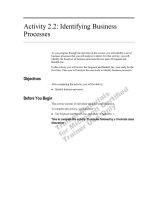Analyzing Business Markets pptx
Bạn đang xem bản rút gọn của tài liệu. Xem và tải ngay bản đầy đủ của tài liệu tại đây (209.21 KB, 20 trang )
Analyzing
Business Markets
Marketing Management, 13
th
ed
7
Copyright © 2009 Pearson Education, Inc. Publishing as Prentice Hall
7-2
Chapter Questions
•
What is the business market, and how
does it differ from the consumer
market?
•
What buying situations do
organizational buyers face?
•
Who participates in the business-to-
business buying process?
Copyright © 2009 Pearson Education, Inc. Publishing as Prentice Hall
7-3
Chapter Questions
•
How do business buyers make their
decisions?
•
How can companies build strong
relationships with business customers?
•
How do institutional buyers and
government agencies do their buying?
Copyright © 2009 Pearson Education, Inc. Publishing as Prentice Hall
7-4
What is Organizational Buying?
Organizational buying refers
to the decision-making process by
which formal organizations establish
the need for purchased products and
services, and identify, evaluate, and
choose among alternative brands
and suppliers.
Copyright © 2009 Pearson Education, Inc. Publishing as Prentice Hall
7-5
Top Business Marketing Challenges
•
Expand understanding of customer needs
•
Compete globally as China and India
reshape markets
•
Master analytical tools and improve
quantitative skills
•
Reinstate innovation as an engine of growth
•
Create new organizational models and
linkages
Copyright © 2009 Pearson Education, Inc. Publishing as Prentice Hall
7-6
Characteristics of Business Markets
•
Fewer, larger
buyers
•
Close supplier-
customer
relationships
•
Professional
purchasing
•
Many buying
influences
•
Multiple sales calls
•
Derived demand
•
Inelastic demand
•
Fluctuating demand
•
Geographically
concentrated buyers
•
Direct purchasing
Copyright © 2009 Pearson Education, Inc. Publishing as Prentice Hall
7-7
Buying Situation
•
Straight rebuy
•
Modified rebuy
•
New task
Copyright © 2009 Pearson Education, Inc. Publishing as Prentice Hall
7-8
The Buying Center
•
Initiators
•
Users
•
Influencers
•
Deciders
•
Approvers
•
Buyers
•
Gatekeepers
Copyright © 2009 Pearson Education, Inc. Publishing as Prentice Hall
7-9
Of Concern to Business Marketers
•
Who are the major decision
participants?
•
What decisions do they influence?
•
What is their level of influence?
•
What evaluation criteria do they use?
Copyright © 2009 Pearson Education, Inc. Publishing as Prentice Hall
7-10
Stages in the Buying Process:
Buyphases
•
Problem recognition
•
General need description
•
Product specification
•
Supplier search
•
Proposal solicitation
•
Supplier selection
•
Order-routine specification
•
Performance review
Copyright © 2009 Pearson Education, Inc. Publishing as Prentice Hall
7-11
Forms of Electronic Marketplaces
•
Catalog sites
•
Vertical markets
•
Pure play auction sites
•
Spot markets
•
Private exchanges
•
Barter markets
•
Buying alliances
Copyright © 2009 Pearson Education, Inc. Publishing as Prentice Hall
7-12
Methods of e-Procurement
•
Websites organized using vertical hubs
•
Websites organized using functional
hubs
•
Direct extranet links to major suppliers
•
Buying alliances
•
Company buying sites
Copyright © 2009 Pearson Education, Inc. Publishing as Prentice Hall
7-13
Handling Price-Oriented Customers
•
Limit quantity purchased
•
Allow no refunds
•
Make no adjustments
•
Provide no services
Copyright © 2009 Pearson Education, Inc. Publishing as Prentice Hall
7-14
Methods for Researching
Customer Value
•
Internal engineering
assessment
•
Field value-in-use
assessment
•
Focus-group value
assessment
•
Direct survey
questions
•
Conjoint analysis
•
Benchmarks
•
Compositional
approach
•
Importance ratings
Copyright © 2009 Pearson Education, Inc. Publishing as Prentice Hall
7-15
Order Routine Specification
•
Stockless purchase plans
•
Vendor-managed inventory
•
Continuous replenishment
Copyright © 2009 Pearson Education, Inc. Publishing as Prentice Hall
7-16
Establishing Corporate Trust
and Credibility
•
Expertise
•
Trustworthiness
•
Likability
Copyright © 2009 Pearson Education, Inc. Publishing as Prentice Hall
7-17
Trust Dimensions
•
Transparent
•
Product/Service
Quality
•
Incentive
•
Partnering
•
Cooperating design
•
Product comparison
•
Supply chain
•
Pervasive advocacy
Copyright © 2009 Pearson Education, Inc. Publishing as Prentice Hall
7-18
Factors Affecting
Buyer-Supplier Relationships
•
Availability of alternatives
•
Importance of supply
•
Complexity of supply
•
Supply market dynamism
Copyright © 2009 Pearson Education, Inc. Publishing as Prentice Hall
7-19
Categories of Buyer-Seller
Relationships
•
Basic buying and
selling
•
Bare bones
•
Contractual
transaction
•
Customer supply
•
Cooperative
systems
•
Collaborative
•
Mutually adaptive
•
Customer is king
Copyright © 2009 Pearson Education, Inc. Publishing as Prentice Hall
7-20
What is Opportunism?
Opportunism is some form of
cheating or undersupply relative to
an implicit or explicit contract.









